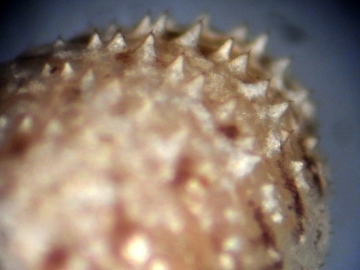Summary for Paroligolophus meadii (Opiliones)
previous species | next species
National Distribution
Terms of Use. Double-click on map to go to region

Explore Regional Distribution
Please log on and add a note on this species
About this species
Recorded altitude range23m to 23m
Species text
DistributionIn the British Isles, Paroligolophus meadii appears to be restricted to England and Wales. A small number of possible Scottish records from museum specimens have proved to be juveniles of other oligolophine species (presumably due to the misinterpretation of characters such as the trident and tubercles which may be disproportionately large in early stages of development). It has not been possible, so far, to verify the HRS record from Brodick Castle on Arran or a literature record for Loch Lomond. However, there would seem to be no reason why it should not occur in Scotland, especially on coastal sand-dunes.
Bloxworth in Dorset is the type locality, from where it was described by Pickard-Cambridge (1890). Until it was discovered in Guernsey in 1955, it was thought to be endemic to Britain. More recently it was found in the Cantabrian Mountains of northern Spain (Martens 1978). However, its use of fairly natural habitats in Britain suggests it has been here for a long time rather than being an introduction from Iberia.
Habitat and ecology
Although this is a fairly widespread species in England and Wales it is uncommon and has scarcely been recorded in the past five years. It prefers drier (and presumably warmer) habitats such as sand-dunes, chalk grassland and heath. Hillyard (2005) notes a preference for habitats with a mix of heather and grass, and its occurrence with Opilio saxatilis. It is a ground-layer species, found amongst the vegetation and also below stones etc.
Nothing seems to have been reported on the diet of P. meadii and much else remains to be discovered about the ecology and life-history of this species.
Adult records in Britain run from August for males, and September for females, through to March, while Hillyard (2005) gives a range from July to December and notes that juveniles have not been recorded before late May. Based on HRS records it seems possible that egg laying may continue beyond December into January but it is unclear why males should persist until March. This requires investigation.
Note on Identification: The potential misidentification of juvenile oligolophines as P. meadii has been highlighted above. It should also be noted that a key character for separating the sub-families Oligolophinae and Phalangiinae is misapplied in Hillyard 2005. Paroligolophus meadii has a ventral spur on the basal segment of the chelicera (as in Mitopus morio) but this is not present in P. agrestis.
NOTE: The HRS Organiser would be pleased to examine recent and historic specimens, please get in touch at hrs@britishspiders.org.uk if you can provide specimens or photographs.
Status
Scarce.
Threats
Loss of habitat - dune/heath/chalk grassland - due to development, environmental change.
Management & Conservation
Resurvey of former sites.
Text based on: Hillyard, P. D. 2005. Harvestmen: keys and notes for the identification of British species. Synopses of the British Fauna 4 (3rd edn). Field Studies Council, Shrewsbury.
References
Martens, J. 1978. Spinnentiere, Arachnida: Weberknechte, Opiliones. Die Tierwelt Deutschlands 64: 1-464. Fischer Verlag, Jena.
Pickard-Cambridge, O. 1890. Monograph of the British Phalangidea or harvestmen. Proceedings of the Dorset Natural History and Antiquarian Field Club, Sherborne/Dorchester 11: 163-216
References
Account last edited by Meg Skinner at 18:17 on Fri 25th Nov 2022.
Adult Season
Habitats
background methodology
Recorded management for locations with Paroligolophus meadii
Recorded substrate and hydrology for locations with Paroligolophus meadii
Images
please log on and upload a new image for this speciesSee also A-Z Species Index - A-Z Picture Index - previous species | next species
